Text
Colosseum: Underground and Ancient Rome Tour
Embark on a guided tour of the Colosseum with skip-the-line tickets and access to the arena, underground, second tier, and more. Experience Roman history and walk in the footsteps of gladiators.
Dive into the wonders of Roman history with an immersive tour through the Colosseum’s different sections with skip-the-line tickets. Enter the arena, underground chambers, ground floor, and more to learn about the Romans and the gladiators on a guided tour. After meeting your guide, you will be able to take some beautiful wide-angle and panoramic photos of the Colosseum and the surrounding areas before the tour begins. Visit the underground chambers and hear stories of the gladiators and wild animals that were kept there. Explore the ground floor level and the second tier, while your guide recreates the past with stories of epic battles, painting a vivid picture and bringing the site to life. Learn about the types of games and ferocious battles that the Romans enjoyed most. See where the emperor would be perched, high above the arena floor, ready to decide the fate of another gladiator as he stood before a roaring Roman crowd. You will also spend 1-hour to see the Roman Forum and Palatine Hill. Allow your guide to point out the best places to capture the perfect picture as you tour the circumference of the Colosseum.
Highlights
Enjoy this tour that will give you access to the Colosseum underground and arena
Visit the most famous monument in the world at your own pace
See the most restrictive Colosseum areas, open only for a small group at a time
What’s Included?
Guide
Skip-the-line entrance ticket to the Colosseum
Access to the underground
Access to arena
Access to the ground floor
Access to the second tier
Access to the exhibition
Headsets to hear your guide clearly
Know before you go
Confirmation will be received at the time of booking
Entrance is strictly limited so you must arrive early. Anyone who arrives after their time slot cannot be accommodated or refunded
The Colosseum portion of the tour will last approximately 1 hour
The Roman Forum & Palatine Hill part of the tour will also last approximately 1 hour
Please be advised that the Colosseum’s capacity regulations and security may delay the tour departure. This could also influence the smooth running of the tour, especially on national holidays and events
0 notes
Text
Trajan’s Market
This well-preserved ancient ‘shopping mall’ with 150 outlets was built by Trajan in the 2nd century AD. It is spread over three levels of a series of semicircular halls, two of which survive in excellent condition behind the Foro di Traiano. The products of the Empire’s trade were sold here - silks, wine, oil, fruit, flowers and fish. Free corn was distributed to the poor in the Congiara at the top of the market.
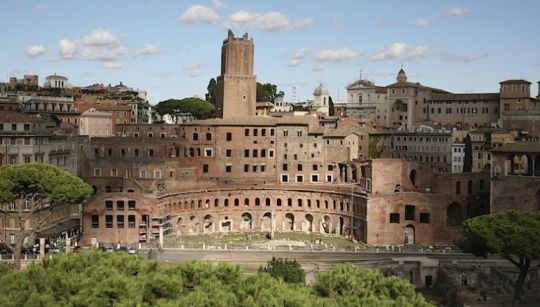
The Via Biberatica (a medieval corruption of the Latin pipera, meaning pepper) was probably where the spice merchants congregated. The lower two storeys of the buildings lining the street appear much as they did in Trajan’s time: the shop entrances with travertine surrounds - not unlike those in use in modern Rome - are cut into brick walls. Little wall openings above led to the mezzanine storage area.
28 notes
·
View notes
Text
Victor Emanuel Monument
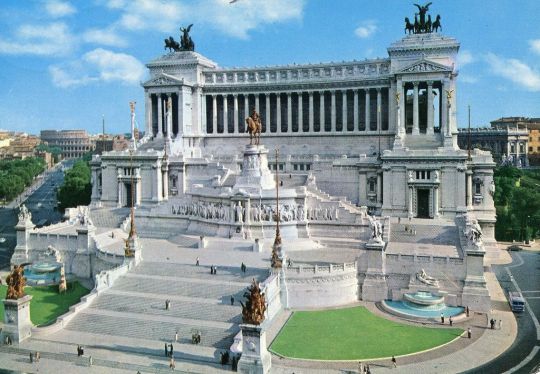
This white Brescian marble monument (1911) to King Victor Emanuel II, first king of a unified Italy, sits on the north slope of the Capitoline. It contains a police station and the archives of the Istituto per la Storia del Risorgimento Italiano (Institute for the History of the Italian Risorgimento). On the terrace above the lower steps is the tomb of the Unknown Soldier, watched by a guard of honour.
4 notes
·
View notes
Text
Forum of Vespasian
Built between AD 71 and 75 by the emperor who began the Colosseum , Vespasian’s Forum is, like the other Imperial Forums, now partly obscured by the Via dei Fori Imperiali. In AD 68 the Jews had rebelled against the Romans and the bitter war that ensued led to the fall of Jerusalem and the Jewish Diaspora. Vespasian used the spoils of the Temple of Jerusalem to construct a huge colonnaded area northwest of the present church of SS Cosma e Damiano (which stands on the site of the forum’s library). It contained the Temple of Peace, dedicated in AD 75, which according to Pliny was one of the principal sights of Rome.
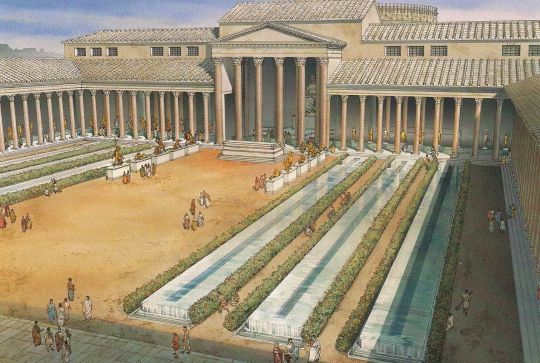
10 notes
·
View notes
Text
Fountain of the Four Rivers
The fountain was completed in 1651 for the Pamphili pope Innocent X. Centre piece of the Piazza Navona, it is one of Bernini’s greatest triumphs. The figures personify the four great rivers of the world: Danube, Ganges, River Plate (whose raised hand is said to be ‘preventing’ Borromini’s Sant’Agnese from falling - a jibe aimed at Bernini’s rival) and Nile (covering its eyes - possibly an allusion to its then unknown source). In the middle, surmounted by the Pamphili armorial dove, rises a Roman obelisk removed from the Circus of Maxentius.

0 notes
Text
Forum of Nerva
Nerva’s Forum (AD 96-8) is represented by two columns - the last remains of a colonnade that once flanked the forum - supporting a frieze that depicts, in relief, the goddess Minerva and a group of women doing their household chores (Minerva was their patroness), along with a ruined podium belonging to the Temple of Minerva.
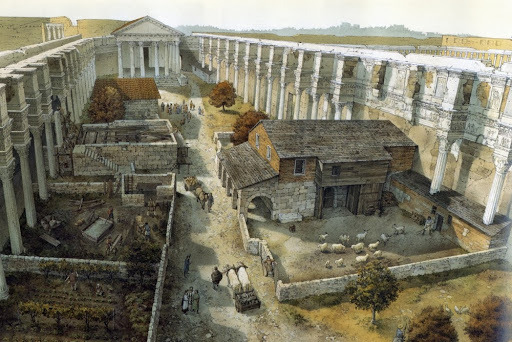
The temple was plundered by Pope Paul V in 1606 to provide the stone for his Fontana dell’Acqua Paola . Also called the Forum Transitorium, because it joined Vespasian’s Forum of Peace with the Forum of Augustus, Nerva’s Forum was constructed over the Argiletum, an ancient street leading into the Subura. Remains of the Argiletum can be seen at the foot of the two columns, the gulleys in its surface the result of years of wear by wagon wheels.
14 notes
·
View notes
Text
S. Andrea della Valle
A richly decorated baroque church with one of the highest domes in Rome after St Peter's. The architect was Carlo Maderno. In the nave are two finely sculpted tombs of the Piccolomini Popes from Siena, Pius II and Pius 3 , brought here from St Peter' s in 1614. Under the dome, some excellent frescoes of the life of St Andrew by Domenichino. The church is perhaps best known as the setting of the first Act of Puccini's opera Tosca.
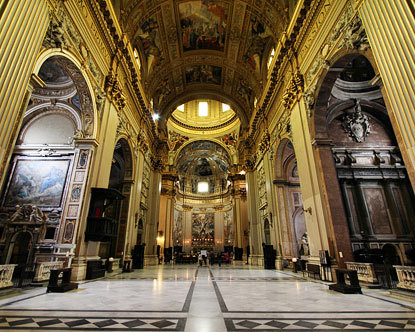
1 note
·
View note
Text
S. Agnese in Agone
A dramatic 17thcentury baroque facade by Francesco Borromini enlivens the centre of the famous piazza.
The church's name refers back almost two thousand years - it is in Agone because it was built on the site of the Emperor Domitian's athletics stadium called the Circus Agonalis. Agone later became corrupted to N'Agona and then Navone.
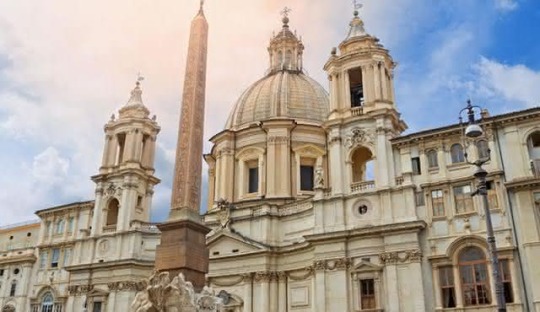
The story of Saint Agnes, who was martyred at the tender age of thirteen, is that she was stripped naked in a Roman brothel near the circus. A miraculous growth of her hair suddenly covered her nakedness and the scene is illustrated in a marble relief in the crypt. There are Roman mosaics under the church with some remains of Domitian's stadium.

0 notes
Text
Basilica di S. Maria Maggiore
The fourth of the patriarchal basilicas was erected by Pope Sixtus III (432-440) in celebration of the Council of Ephesus which proclaimed the Virgin Mary, Mother of God. The classical 13th-century exterior gives no hint of the riches you will find inside - the glowing purity of the original mosaic decoration dating from the time of Sixtus. Above the architrave are 36 mosaic panels of Old Testament scenes (a pair of binoculars will be of help in identifying them). The triumphal arch at the end of the nave is decorated with scenes of the Annunciation and the childhood of Christ, with special emphasis on the Virgin, portrayed as a Byzantine princess. The original mosaics in the apse were replaced in the 12th century by Iacomo Turriti, who also worked on the mosaics in the apse of S. Giovanni Laterano.
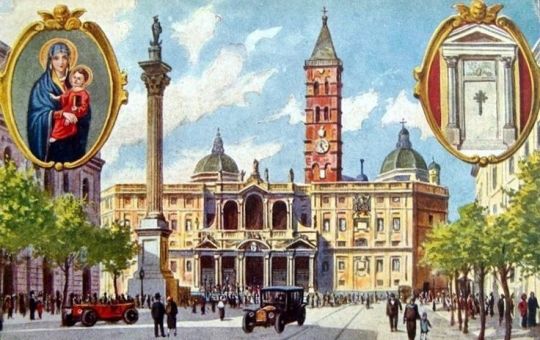
In medieval times there existed at the side of the basilica an oratory dedicated to the Presepio, or Christ's Crib. It was built to resemble the grotto where Christ was born in Bethlehem and was filled with precious offerings of gold, silver and jewels - all looted during the sack of Rome in 1527. Arnolfo di Cambio's original figures of the three Kings, St Joseph and the ox and the ass survived but most of Arnolfo's work was destroyed during the building of the Capella Sistina (named after Pope Sixtus V, not the same Sixtus after whom the Sistine Chapel in the Vatican was named). The surviving statues, beautiful examples of medieval mysticism, are in a grotto below the chapel. The gate to the steps is closed. Ask in the sacristy for someone to open it for you. The afternoon is the best time.
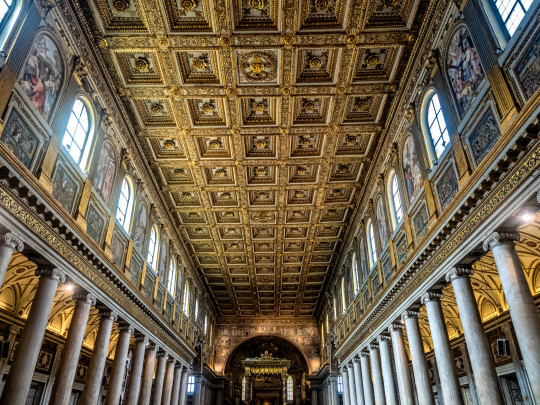
Opposite in the left transept is the Cappella Paolina (Pauline Chapel), built to house the tombs of the Borghese Pope Paul V and the AldobrancUni Pope Clement VIII. The semi-precious stones used for the sculpture - jasper, amethyst, agate and lapis lazuli - would be worth a king's ransom today. One of the sculptors was Pietro Bernini, father of the famous Gian Lorenzo.
On August 5 each year a shower of white petals is released from the ceiling of the chapel in commemoration of the legendary summer snowfall which is said to have inspired a 4th century Pope to build another (long vanished) church nearby on the Esquilino, dedicated to the Virgin.
1 note
·
View note
Text
Basilica di S. Paolo fuori le Mura
St Paul's-outside-the- Walls, is or rather was, the second largest basilica in Rome after S. Pietro. A disastrous fire in 1823 gutted the building which had remained basically unchanged for 1400 years. Although rebuilt according to the former ground plan, the modern S. Paolo remains a coldly neo-classical temple despite the care and expense lavished upon its thirty year reconstruction. It took place at the nadir of Rome's unparalleled architectural history.

The altar canopy by Arnolfo di Cambio (1285) and the elaborate paschal candlestick are the only notable objects to have survived the fire. But do not fail to visit the exquisite 12th-century cloister which escaped unscathed. The variety and finesse of the stone carving, and the well-kept garden is an oasis of tranquillity and beauty among the desert of faceless suburbs around the basilica. Metropolitana S. Paolo.
1 note
·
View note
Text
Tivoli and Hadrian’s Villa
The ancient Roman Tibur has always been a favourite hill resort for Romans, but it is now threatened by uncontrolled urban sprawl. Two summer palaces, one now in ruins, as it was built 1800 years ago by the Emperor Hadrian, and the other with a notable Renaissance garden are worth seeing.

The Villa d'Este, originally a convent, was constructed by Cardinal Ippolito d'Este in 1550. In front he created one of the great water-gardens of Europe with more than 500 fountains fed from an aqueduct that passes under the town. One fountain used to play organ music through the 16th century equivalent of a modern juke-box - a hydraulic organ. In summer the gardens are illuminated in the evening, but Outside Rome 123 beware the crowds. The Villa d'Este is now alas considered by tour operators to be one of the major sights of Rome and draws cohorts of tourist buses. Open 0900-1830 and from May to September 2000-2230. Closed Mon.
The Villa Adriana (Hadrian's Villa) was the largest and richest of all Roman Imperial villas. It was built between ad 118-34 at the foot of the mountain on which Tivoli is situated. Hadrian wanted to recreate some of the places which had most impressed him on his travels in the Empire - so there were imitations of famous buildings in Athens, a landscaped garden representing the Vale of Tempe in Thessaly in Greece, and a canal and temple to Serapis he had seen in Egypt. Hadrian died shortly after the completion of his sumptuous villa, and over the centuries the Emperor's grandiose pleasure park was gradually despoiled of its statuary, marbles and mosaics. Cardinal Ippolito d'Este did not hesitate to use the Villa as a quarry for building his own residence up the hill.

Systematic excavations were carried out from the time of Pope Alexander VI at the end of the 15th century. Hundreds of works of art dug up here have found their way into museums and collections all over Europe. Allow at least 2-3 hours to wander around one of the world's most impressive archaeological sites. Open 0900 to one hour before sunset. Closed Mon.
#tivoli#rome#roma#italy#italia#villa adriana#hadrians villa#roman empire#roman history#hadrian#travel
42 notes
·
View notes
Text
Ostia Antica
A visit to the ruins of the ancient seaport of Rome is one of the most interesting excursions around the city, as it gives a much better idea of Roman urban life than any of the random remains which have survived within the city walls. The sea has receded more than a mile since ancient times, and the River Tiber changed its course after a flood in 1575.
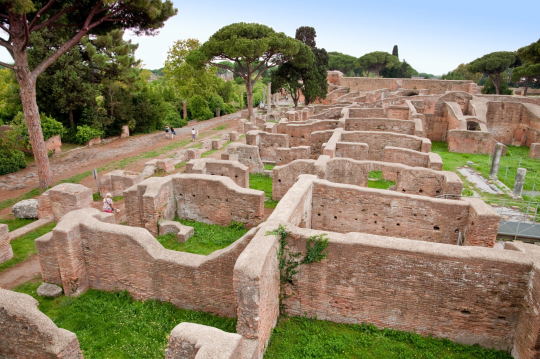
But the general layout of the port city together with theatre, forum, temples, public baths, shops and private nouses many with their original mosaic or inlaid marble floors, is clear from the moment you set foot in the Decumanus Maximus, or Main Street, whose original paving stones are still rutted by chariot wheels. Past the theatre, look out for the Via Diana and the Thennopolium (the nearest Latin could get to a bar) with its marble drinks counter and paintings of food and beverages for sale. (Incidentally the modern bar is installed under one of the arches of the theatre, if you get thirsty).
The Romans coped with urban overcrowding by building multi-storey apartment houses. The blocks were called insulae or 'islands' and the remains of several such high-rise buildings statad near the Thermopolium.
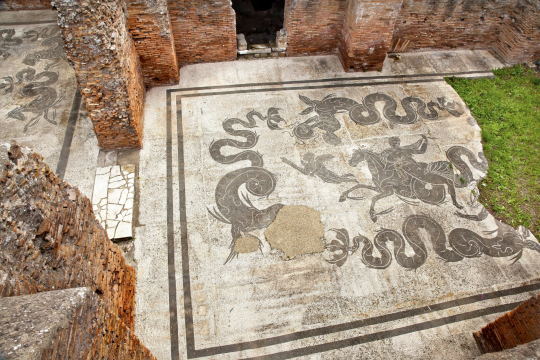
A small museum (enquire for opening times) contains some interesting pieces of sculpture, mosaics, and-sarcophagi unearthed during the excavations which are still continuing. In summer open air performances of classical plays are given in the ancient theatre. Open 0900-one hour before sunset. Closed Mon. and most public holidays. You can drive your car into a park inside the excavations on payment of a small additional fee.
Train frequent service from Roma Lido Stazione (Metropolitana Piramide) By road take the Via del Mare (near S. Paolo fuori le Mura), Italy's first motorway (where Mussolini used to like speeding in a souped-up Lagonda) and turn off at Ostia Antica.
0 notes
Text
Theater of Marcellus
This 20,000 seat amphitheatre was begun by Julius Caesar and completed after his death by Augustus. It was dedicated in 13 bc to his nephew and son-in-law Marcus Claudius Marcellus who died in his early twenties. During the Middle Ages the ruins were transformed into a fortress.

The Savelli family rebuilt it as a Renaissance palace which then passed into the possession of the Orsini family. It has now been split up into apartments.
The exterior of the theatre was cleared by Mussolini of the small shops and workshops which had grown up under the arches during the centuries. Nearby you can see the remains of the Portico d'Ottavia erected by Augustus and dedicated to his sister.
This colonnaded building contained temples and libraries and was adorned with many works of art including the Medici Venus, found under the rubbish of the fish market which grew up around here in the Middle Ages, now to be seen in the Uffizi Museum in Florence.
Remains of some of the 300 columns of the Portico can be seen sticking out of the pavement in the Via di Portico d'Ottavia or incorporated into nearby buildings. This is the beginning of the ghetto area where the Jews of Rome were once forced to live. A 13th-century Pope was the first ruler to decree that Jews should wear a distinguishing mark - a yellow O. Jews were not allowed to practise a profession or own land right up until the unification of Italy in 1870. Not open to the public.
0 notes
Text
Pyramid of Cestius
Rome's only extant pyramid is a poor imitation of its Egyptian model. It was constructed by a wealthy Roman politician as his tomb in about 12 bc. The inscription tells us that one of Caius Cestius' jobs was the supervision of solemn sacrificial banquets and that the pyramid took 330 days to build.
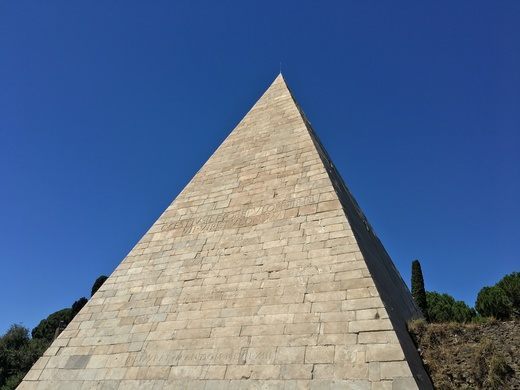
Do not fail to visit the nearby Cimitero Protestante (Protestant Cemetery) where Keats and Shelley are buried.
0 notes
Text
Mausoleum of Augustus
Augustus' family tomb was clearly inspired by the burial mounds of the Etruscans such as those you can see at nearby Cerveteri (see Out of Rome). The Mausoleum had a chequered history as medieval fortress, would call a smart residential area; later it was taken over by the Emperors for their own residences.
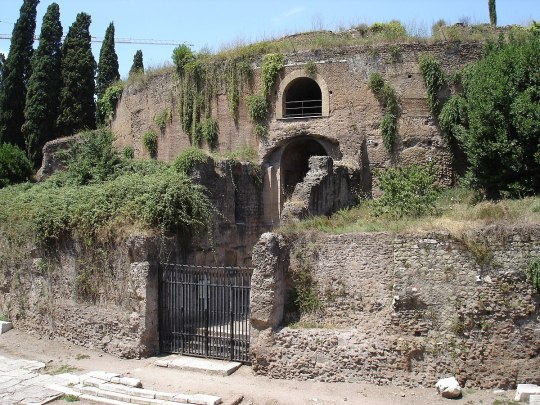
After Decline and Fall had set in, part of the Palatino became a pleasure garden of the Farnese family. Vineyards and vegetable plots nourished among the ruins. Now it is almost the only part of central Rome which gives you an idea of the rusticity of the city which lasted for many centuries until modern urban sprawl began to swallow up the past.

The general impression of the Palatino is more important than its archaeological detail which is difficult for the layman to decipher. The Palatino can conveniently form the subject of a separate visit from the Foro Romano but if you can only spare the time for one visit, do at least climb up to see the exceptional view over the Foro from the north-east corner of the hill. This is not far from the point where the legendary she-wolf was supposed to have suckled Romulus and Remus. In ancient times a shrine marked the spot. In modern times a rather seedy she-wolf was kept in a cage but someone forgot to feed her. The cage has now been empty for many years.

Tiberius was the first emperor to build his palace on the Palatino. The ruins of Domitian's residence are the largest single group of archaeological remains. They include a private stadium and Domitian's dining-rooms. Septimius Severus built baths as well as a palace here.
There is a fine view to be obtained from the ruins of the former Imperial box overlooking the Circus Maximus racetrack. Try to visualize the scene below the garlanded Emperor as he presided over a day of hectic chariot races. If you find this difficult, fill in the details for yourself with a book called Daily Life in Ancient Rome by Jerome Carcopino, a former director of the French Academy in Rome, who gives a rich and detailed picture of what life must have been like in the ancient city.
Before leaving the Palatino do not fail to visit the Casa di Livia (Livia's House) to see some fine examples of interior decoration of a Roman house. The contrast between the delicate fresco painting and the grandiose ruins around could not be more striking. If Augustus and his Empress did not actually live in this house, this was the sort of decor with which they were familiar.
Photo Credit: Colosseum Rome Tickets
0 notes
Text
The Castelli Romani
There are thirteen villages in all, scattered among the chestnut trees and vineyards of the Alban Hills, which are volcanic in origin.
Their names are: Albano Laziale, Ariccia, Castel Gandolfo, Colonna, Frascati, Genzano, Grottaferata, Marino, Monte Compatri, Monte Porzio Catone, Nemi, Rocca di Papa, and Rocca Priora.
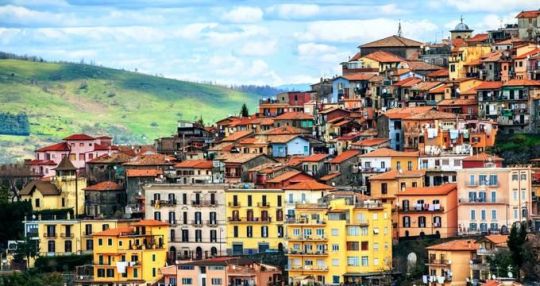
How distant now seems the memory of that ancient duel, when the Roman brothers Horatii slew the Curiatii, masters of Alba Longa! And the role of these villages as strongholds and places of refuge for Rome's medieval nobility also seems lost in the mists of time. Today, the Castelli Romani are destinations for Sunday excursions, and swarm with friendly little restaurants.
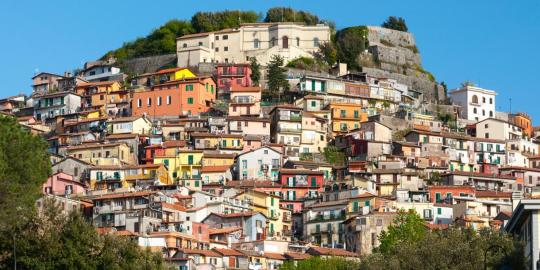
Their role started to change way back in the sixteenth century, when the great families began to build summer residences in the area. Many of them, notably the Aldobrandini, chose Frascati, the village nearest Rome and famous for its marvellous wines. They constructed handsome villas on the heights, setting them in typical Mannerist gardens complete with fountains and rockeries. The popes appropriated the most desirable and best-protected site - the small village of Castel Gandolfo, ancient Alba Longa, clinging to a hill with a grandstand view of Lake Albano. They went to any lengths to escape the suffocating
4 notes
·
View notes